
How to Use atmega328: Examples, Pinouts, and Specs
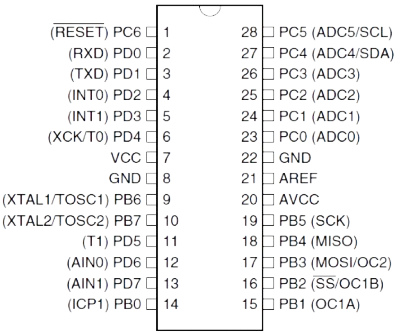
 Design with atmega328 in Cirkit Designer
Design with atmega328 in Cirkit DesignerIntroduction
The ATmega328 is a high-performance, low-power 8-bit microcontroller from the AVR family, developed by Microchip Technology. It is widely recognized for its use in embedded systems and is the core microcontroller in popular Arduino boards like the Arduino UNO. With 32 KB of flash memory, 2 KB of SRAM, and 1 KB of EEPROM, the ATmega328 is well-suited for a variety of applications, including automation, robotics, IoT devices, and control systems. Its 23 general-purpose I/O pins and versatile peripheral features make it a favorite among hobbyists and professionals alike.
Explore Projects Built with atmega328
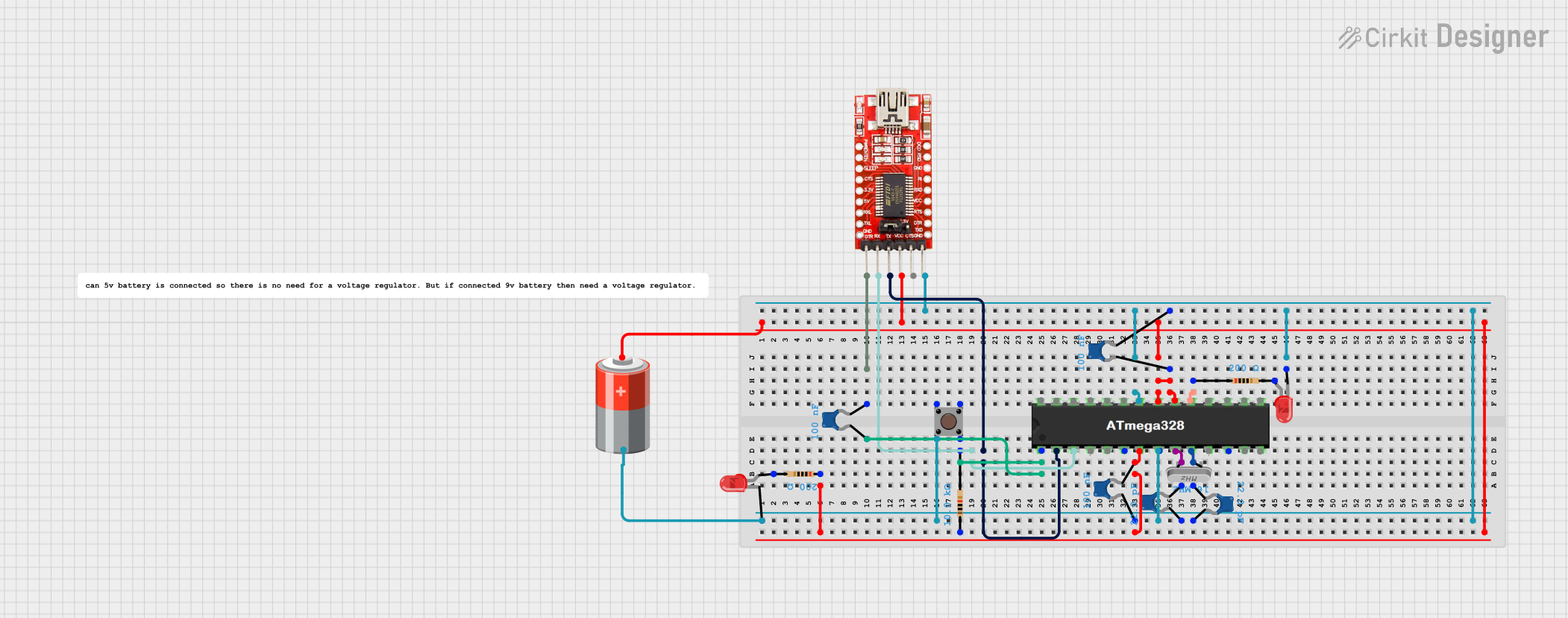
 Open Project in Cirkit Designer
Open Project in Cirkit Designer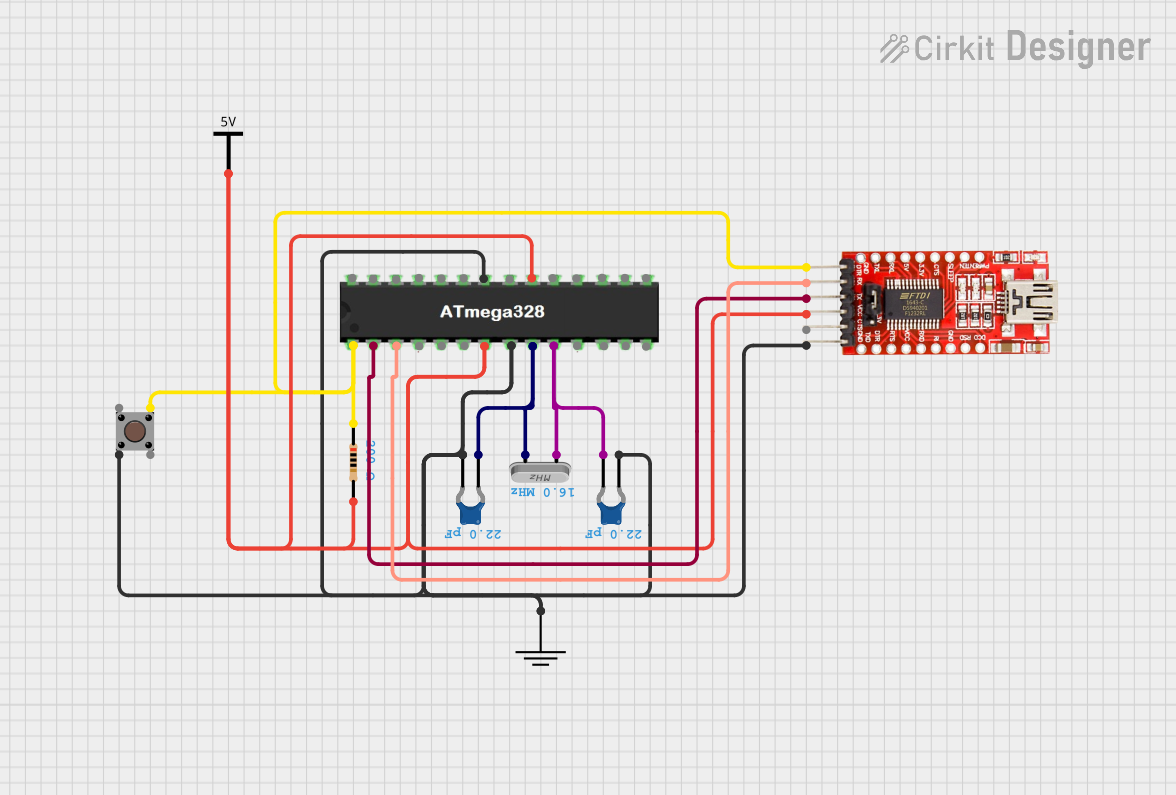
 Open Project in Cirkit Designer
Open Project in Cirkit Designer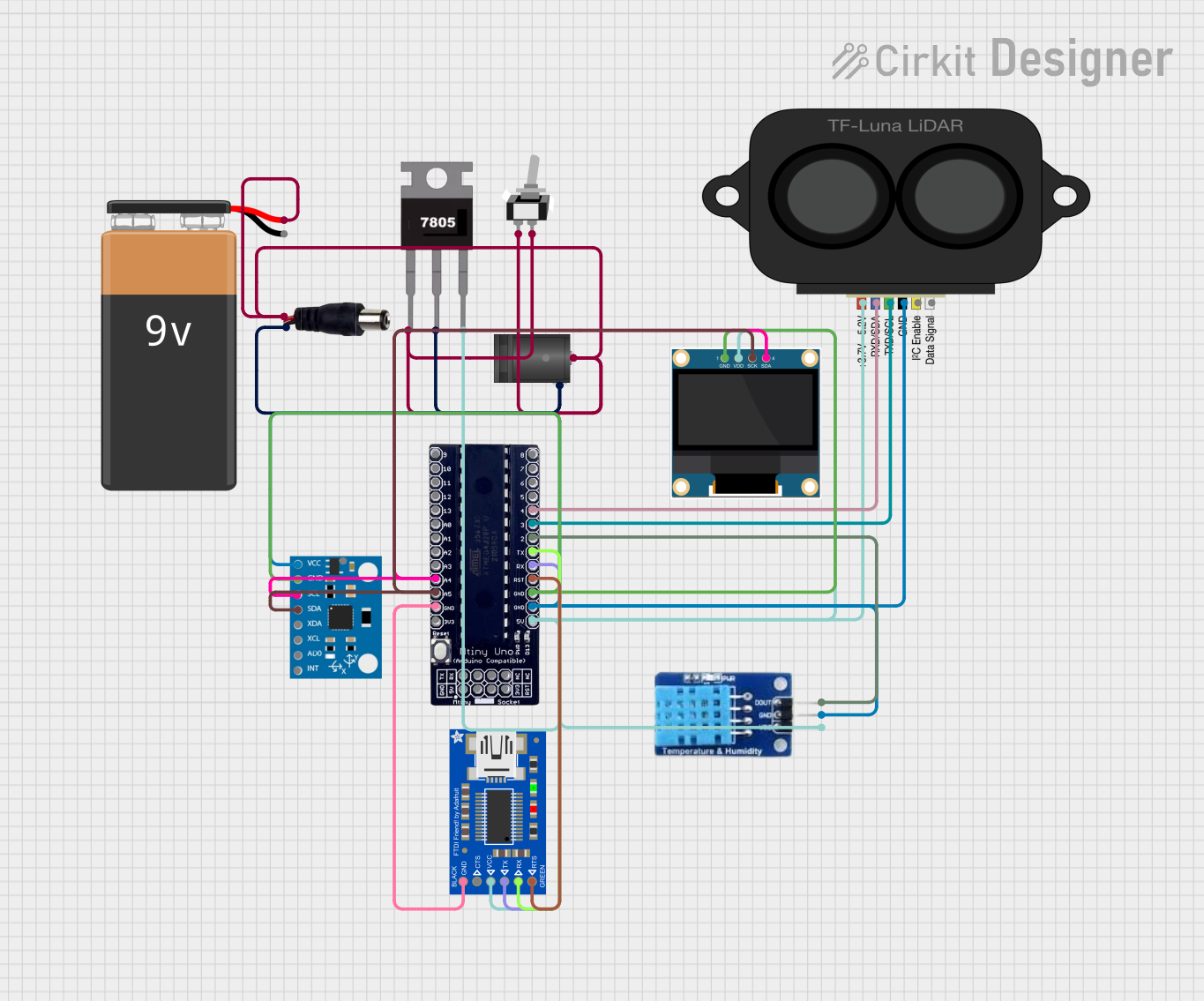
 Open Project in Cirkit Designer
Open Project in Cirkit Designer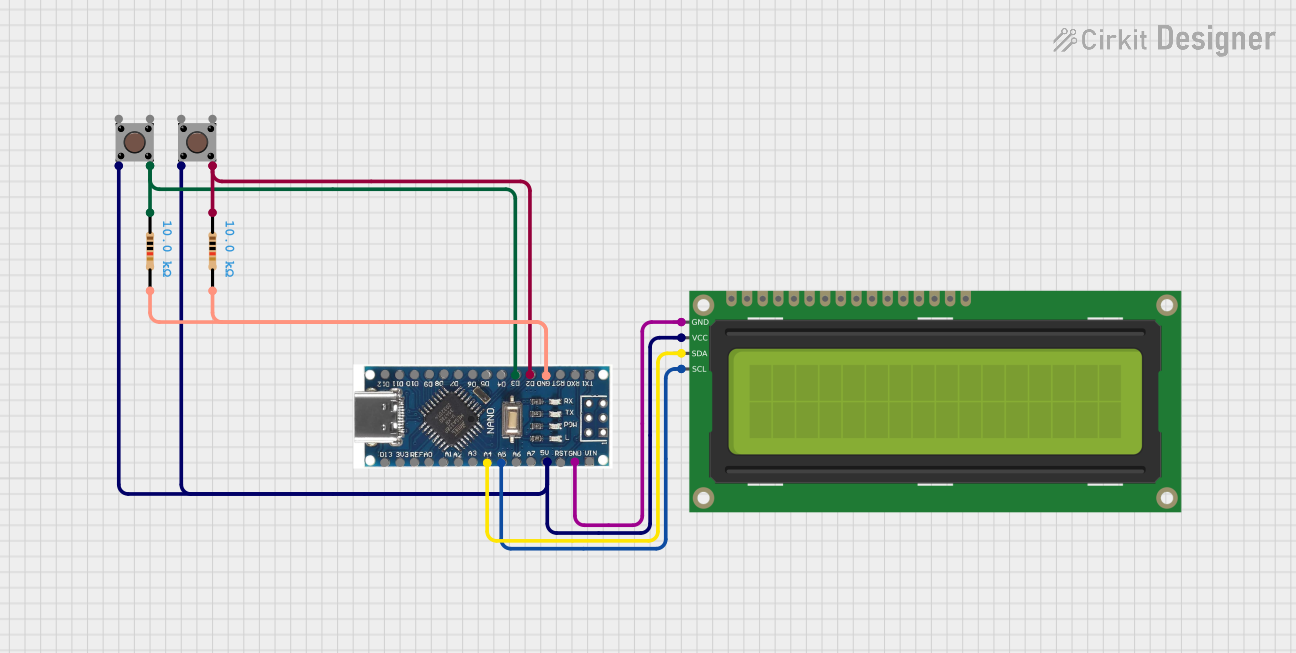
 Open Project in Cirkit Designer
Open Project in Cirkit DesignerExplore Projects Built with atmega328

 Open Project in Cirkit Designer
Open Project in Cirkit Designer
 Open Project in Cirkit Designer
Open Project in Cirkit Designer
 Open Project in Cirkit Designer
Open Project in Cirkit Designer
 Open Project in Cirkit Designer
Open Project in Cirkit DesignerCommon Applications:
- Home automation systems
- Robotics and motor control
- IoT (Internet of Things) devices
- Data logging and sensor interfacing
- Educational and prototyping platforms (e.g., Arduino projects)
Technical Specifications
Key Technical Details:
| Parameter | Value |
|---|---|
| Microcontroller Family | AVR |
| Architecture | 8-bit |
| Operating Voltage | 1.8V - 5.5V |
| Flash Memory | 32 KB |
| SRAM | 2 KB |
| EEPROM | 1 KB |
| Clock Speed | Up to 20 MHz |
| I/O Pins | 23 General-Purpose I/O Pins |
| ADC Channels | 6 (10-bit resolution) |
| PWM Channels | 6 |
| Communication Interfaces | UART, SPI, I2C (TWI) |
| Power Consumption | Low Power (Active: ~1 mA @ 1 MHz) |
Pin Configuration and Descriptions:
The ATmega328 is available in multiple packages, such as DIP-28, TQFP-32, and QFN-32. Below is the pinout for the DIP-28 package, which is commonly used in Arduino boards.
| Pin Number | Pin Name | Description |
|---|---|---|
| 1 | PC6 (RESET) | Reset Pin (Active Low) |
| 2 | PD0 (RXD) | UART Receive (Serial Communication) |
| 3 | PD1 (TXD) | UART Transmit (Serial Communication) |
| 4 | PD2 | Digital I/O Pin 2, External Interrupt 0 |
| 5 | PD3 | Digital I/O Pin 3, PWM Output, External Interrupt 1 |
| 6 | PD4 | Digital I/O Pin 4 |
| 7 | VCC | Power Supply (2.7V - 5.5V) |
| 8 | GND | Ground |
| 9 | PB6 (XTAL1) | External Oscillator Input |
| 10 | PB7 (XTAL2) | External Oscillator Output |
| 11 | PD5 | Digital I/O Pin 5, PWM Output |
| 12 | PD6 | Digital I/O Pin 6, PWM Output |
| 13 | PD7 | Digital I/O Pin 7 |
| 14 | PB0 | Digital I/O Pin 8 |
| 15 | PB1 | Digital I/O Pin 9, PWM Output |
| 16 | PB2 | Digital I/O Pin 10, PWM Output |
| 17 | PB3 | Digital I/O Pin 11, PWM Output, SPI MOSI |
| 18 | PB4 | Digital I/O Pin 12, SPI MISO |
| 19 | PB5 | Digital I/O Pin 13, SPI SCK |
| 20 | AVCC | Analog Power Supply |
| 21 | AREF | Analog Reference Voltage for ADC |
| 22 | GND | Ground |
| 23-28 | PC0-PC5 | Analog Input Pins (ADC Channels 0-5) |
Usage Instructions
How to Use the ATmega328 in a Circuit:
- Power Supply: Connect the VCC pin to a regulated power source (2.7V to 5.5V) and GND to ground. For analog operations, connect AVCC to the same voltage as VCC and ensure proper decoupling capacitors are used.
- Clock Source: Use an external crystal oscillator (e.g., 16 MHz) connected to XTAL1 and XTAL2 pins, along with appropriate capacitors, or use the internal 8 MHz oscillator.
- Programming: The ATmega328 can be programmed using an ISP (In-System Programmer) or via a bootloader (e.g., Arduino IDE with a USB-to-serial adapter).
- I/O Pins: Configure the I/O pins as input or output in the firmware. Use pull-up resistors for input pins if needed.
- Communication: Utilize UART, SPI, or I2C for interfacing with other devices.
Example: Using ATmega328 with Arduino UNO
The ATmega328 is the microcontroller used in the Arduino UNO. Below is an example code to blink an LED connected to digital pin 13.
// Blink an LED connected to digital pin 13
void setup() {
pinMode(13, OUTPUT); // Set pin 13 as an output
}
void loop() {
digitalWrite(13, HIGH); // Turn the LED on
delay(1000); // Wait for 1 second
digitalWrite(13, LOW); // Turn the LED off
delay(1000); // Wait for 1 second
}
Best Practices:
- Use decoupling capacitors (e.g., 0.1 µF) near the power pins to reduce noise.
- Avoid exceeding the maximum voltage and current ratings for the pins.
- Use proper pull-up or pull-down resistors for unused pins to prevent floating states.
- For ADC operations, ensure the AREF pin is connected to a stable reference voltage.
Troubleshooting and FAQs
Common Issues:
Microcontroller Not Responding:
- Cause: Incorrect power supply or missing decoupling capacitors.
- Solution: Verify the power connections and add decoupling capacitors near the VCC and AVCC pins.
Program Upload Fails:
- Cause: Incorrect bootloader or communication settings.
- Solution: Ensure the correct COM port and board are selected in the Arduino IDE. Reflash the bootloader if necessary.
Analog Readings Are Inaccurate:
- Cause: Unstable reference voltage or noise on the analog pins.
- Solution: Use a stable voltage source for AREF and add filtering capacitors to the analog input pins.
I/O Pins Not Working:
- Cause: Pins not configured correctly in the code.
- Solution: Double-check the
pinMode()configuration in the firmware.
FAQs:
Q: Can the ATmega328 run without an external crystal?
- A: Yes, it can use the internal 8 MHz oscillator, but an external crystal provides better accuracy.
Q: What is the maximum current per I/O pin?
- A: Each I/O pin can source or sink up to 40 mA, but it is recommended to limit it to 20 mA for reliability.
Q: How do I reset the ATmega328?
- A: Pull the RESET pin low momentarily to reset the microcontroller.
Q: Can I use the ATmega328 for low-power applications?
- A: Yes, the ATmega328 supports various power-saving modes, such as idle, power-down, and standby.
This concludes the documentation for the ATmega328 microcontroller.